 |
|||||||||||||||
 |
|||||||||||||||
| In the silken refinement class, four rooms stood out. Three of them used tubes for output devices. Hallelujah. My favorite of the four? Transistors - with tubes merely in the driver stage. Argh. Just kidding. But go figure. The times of clear-cut distinctions ain't what they used to be. Two of these rooms employed Ed Meitner's EMM Labs DAC and Switchman preamp, the former optically connected to a modified Philips universal transport which allowed data conversion of 16bit/44.1kHz Redbook to SACD standard. The treble quality in these Kharma/Tenor Audio exhibits was arguably the best at the whole show - airy, luminous, effortless, without any texture whatsoever. Easy. |
|||||||||||||||
| I predict that this particular digital front-end could well be the new bleeding edge performance champ dethroning dCS and Anagram-derived converters. With deep roots in the professional recording arena, many features of Meitner's products exceed consumer needs. Wouldn't a 2-channel DAC with integral volume control -- hardwired like the ultra-kewl current one -- be the horny cat's meow for many diehard stereoists? The company representative merely grinned. One such beast is already in the works. Mark my words - this could well be what hotblooded Redbook devotees will want to want more than their remaining sanity. I hereby officially put my name on a review sample. Pretty please? But certainly, the front-end wasn't the only magic in these rooms. Here's what else was on gushing tap: |
|||||||||||||||
 |
|||||||||||||||
 |
|||||||||||||||
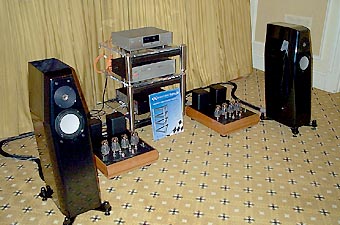 |
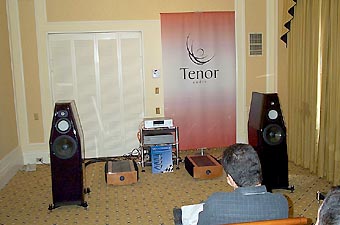 |
||||||||||||||
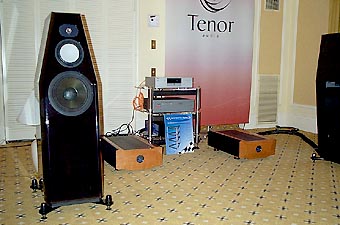 |
 |
||||||||||||||
The bigger setup -- next to Avantgarde/BAT, my other favorite show destination -- involved the Tenor Audio hybrid 300Hp monos capable of delivering 300, 600 and over 1000 watts into 8, 4 and 2 ohm loads respectively and using 6 driver tubes responsible not only for the overall gain [left - the five tubes of the 150-watt stereo version] but HSI - Tenor's acronym for Harmonic Structural Integrity, a marketing buzzword pointing at a specific harmonic distortion spectrum. As the recent AUDIOPAX review in Stereophile proved, the higher THD levels of especially single-ended triode amps without corrective feedback still completely mystify the test bench. It doesn't see rhyme or reason for its existence and writes it off as plain wrong. A simple listen with copacetic speakers however, would quickly silence detractors who can put their mental conditioning on hold. My question to all such measurement freaks: Do these devices sound so good despite their distortion? Or precisely because of it? You decide. I know what I believe. Why would a talented firm like Tenor go through the trouble to add (so-called) distortion into a solid-state circuit, only to reap continuous "Best of Show" or at least "amongst the best" accolades very much like Vladimir Shushurin of LAMM who still hasn't managed to produce anything but first-class sound each time I've heard one of his exhibits. And he's producing thermionic distortion in spades! |
|||||||||||||||
 |
|||||||||||||||
 |
|||||||||||||||
 |
|||||||||||||||
 |
|||||||||||||||
| Using his Grand Ceramique Midi 1.0 with Tenor's big boyz, Charles van Oosterum of the heavy Kharma poses next to the smaller Ceramique 3.1 used to equally splendid effect in the adjacent room with Tenor's popular 6C33C OTL tube amps. Like the Lumen White speakers (our next entrant) and the Scandinavian Marten Design models, Charles is sold on the very expensive German Accuton ceramic drivers by Thiel & Partner who, in April of 2001, announced the world's first transducer with a diamond membrane: The D²20-6, effective from 2 kHz to almost 100 kHz, with harmonic distortion said to be magnitudes lower than conventional tweeters, with sound propagation velocity of 18,000 m/sec, the highest of any existing material. Noticed a paradox? Specific THD in amps good, ultra-low THD in drivers good, too? | |||||||||||||||
I do you one better. Many a good-sounding room in San Francisco featured digital amplifiers: JMlab (Bel Canto); Audio Physic (Audio Physic); Gallo & Vandersteen (Spectron); Gershman Acoustics (PS Audio). Add two distinguished firms whom I didn't spot -- Audio Research (Tripath-based like Bel Canto) and Jeff Rowland Design Group (Bang & Olufsen ICE Power-based) -- and there's a decidedly growing momentum in bona fide High-End amplification circles, for ultra-efficient variations on digital topologies. While they sound different again from SOTA tube efforts, they sound very good as well. One single recipe of design philosophies, output devices and circuit topologies clearly doesn't cover all bases of satisfying sound. It makes predictions about why, exactly, particular rooms performed better than others mostly the work of fiction. Audio reviewers = Science Fiction pen jockeys? Who woulda thunk. Give us that next Nebula award. Or is that only bestowed on Fantasy? |
|||||||||||||||
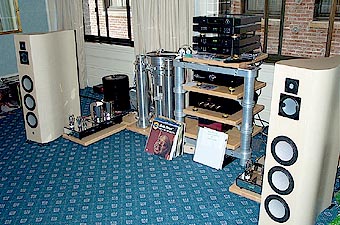 |
 |
||||||||||||||
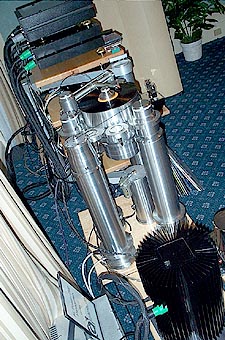 |
|||||||||||||||
| The Lumen White exhibit with the White Light speaker models optionally available with the afore-mentioned diamond tweeter sounded equally suave, unfettered, billowy, natural and luminous. When I dropped in, the Ayon Audio Classic 300B monos were providing juice but MSB's radical solid-state porcupine towers were in stand-by as alternate power engines. dCS decoded the digital pixels - er, bits while a long-legged V.Y.G.E.R. with linear tracking arm gave great analogue. Like the Kharma/Tenor rooms, the guys here revelled in first-class music at just the right output level - bravo! Their great music syndrome was in stark contrast to Ayon's stand-alone exhibit playing the firm's own Falcon speaker that I was keen on hearing ever since Shunyata's Caelin Gabriel had confided that a pair of their Dragons was bound for his pleasure-listening system. Alas, the fellow running said display was so absent-minded, of such sour visage as to suggest he'd just swallowed a rat who had swallowed rat poison itself... and he played a gawd-awful instrumental e-guitar rendition of Roberta Flack's "Killing me softly" (and some Chinese xylophone next time I stuck my head in) that I bolted in utter consternation and disgust. Let's hope I caught this exhibit during a momentary lapse of good manners and paying attention. Or else I'd say Ayon sent the wrong man to represent them in public. Which brings us to our last room in this "Silk Class" category of sound whose overriding attribute, as a group, was mellifluousness: The Alon by Acarian/DeHavilland display. |
|||||||||||||||
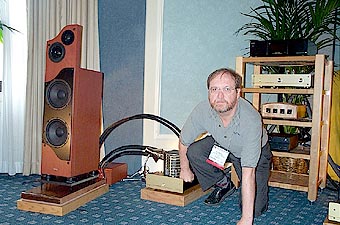 |
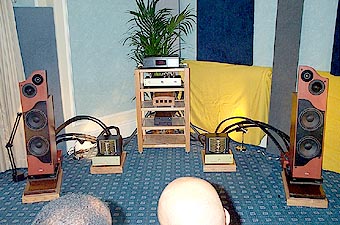 |
||||||||||||||
In a room far smaller than either of the previous entrants but cleverly maximized via a diagonal setup, the overall scale of the presentation was naturally reduced, and the far more modest front-end of the $2,500 Sony SCD-777ES and $1,500 CAL Alpha 24/96 DAC not quite as refined and transcendental as the Meitner and RingDAC units. Still, the essential quality of raw silk was palpable, with a free-floating diaphanous soundstage and excellent low-level ambience retrieval. Amplification was by DeHavilland Electric Amplifier Company whose George Kielczymski sits in front of their $3,000 SuperVerve Octal Tube Preamplifier and the $6,000 Aries 845-G SET monos. Loudspeakers were Carl Marchisotto's Alon by Acarian $8,000 Lotus Elite Signature with Alnico magnets, the latter an expensive boon of distinction said to be particularly well suited to bring out the best in triode amplification. That's certainly what it sounded like. Chrome-dome Wes Phillips [right] entered a few minutes later and looked so slimmed down that Mrs. Marchisotto barely recognized him. Wes' large pirate's earring put my little turquoise jobbie to shame and could have caused undue attention in the city's active Castro district. Is membership in that club indicated by the left or right ear? Darn, I could be in trouble if I don't sort this out soon. But judging from Wes' happy facial expression during a female vocal track he'd brought, I gather he enjoyed this presentation as much as I did. I'd be remiss not to mention PranaWire Cable System's contribution to the outstanding results here. Still, a look at the final tally ($42,500 for the complete system, $21,500 for the cables alone) makes me question how many consumers would be apt to spend 50% of their budget on the wiring alone. I appreciate how Prana's Joe Cohen wanted to show off his best efforts. Still, I prefer to keep things in perspective. Assemble a system whose financial balance reflects the pervasive logic of the real world. This concludes my special-attention picks in the Silk category. To be sure, separating sound into distinct classes is an exercise in lunacy (and thus perfectly legit on the 6 moons). Still, it's a useful metaphor to hint at the tacit flavors that distinguished certain presentations. It's also a convenient means whereby to separate between certain personal favorites. Men, as you know, like to have their cake and eat it, too. Multiple choice. We're such floozies ... |
|||||||||||||||
 |
 |
||||||||||||||
 |
|||||||||||||||